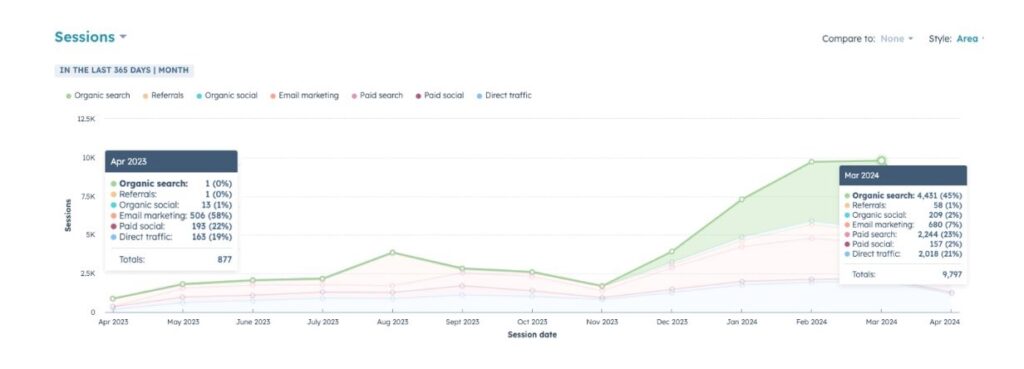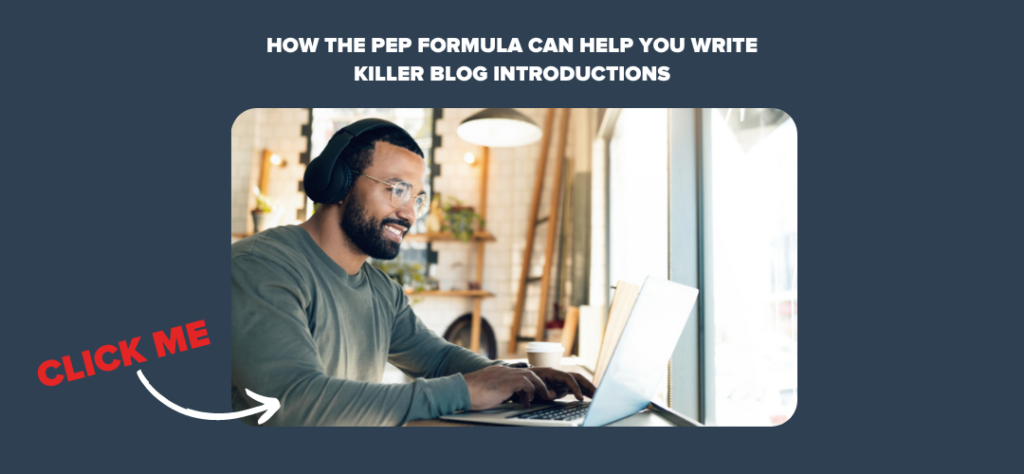What’s the hardest part of writing a blog post? If you guessed the introduction, you’re spot on. Crafting a blog introduction that grabs attention and makes readers want to stick around is one of the biggest challenges bloggers face. But here’s the problem: if your introduction fails to engage, readers won’t stick around to reading the rest of your content—no matter how valuable it is.
Luckily, you don’t need to be a literary genius to write introductions that work. With the right approach and a simple framework, you can write intros that hook your readers from the very first line.
I’ve used these same tactics in over 200+ blog articles, and the traffic we’ve been able to generate is the proof in the pudding.

One of our clients was able to use these tactics to generate over 4000 organic website visitors per month after an 8 month period.
And now I’m going to show you how to structure your introductions using a proven formula and give you six tried-and-tested introduction styles that are sure to grab attention.
By the time you finish this article, you’ll be confident in your ability to write blog introductions that not only capture your reader’s interest but keep them reading.
Why the Introduction Matters
You’ve likely heard the saying, “You never get a second chance to make a first impression.” This applies to your blog as well.

Your introduction is the first thing your readers see, and it determines whether they’ll stick around or bounce off your page.
In fact, studies show that you only have 15 seconds to capture your reader’s attention before they decide to leave. That means your intro has to do a lot of heavy lifting in a very short amount of time.
A killer introduction hooks your audience, sets expectations, and builds trust right from the start.
It’s not just about grabbing attention—it’s about creating a connection. If your readers feel like you understand their problem and you have the solution, they’ll be far more likely to continue reading.
Fail to do this, and your carefully crafted content will go to waste. Even the best blog posts can fall flat if their introductions don’t compel readers to keep going.
The PEP Formula for Blog Introductions

To consistently write introductions that grab your reader’s attention, you can follow a simple but powerful formula: PEP. It stands for Problem, Expertise, and Promise.
Let’s break it down:
- Problem – Identify the issue your reader is facing. This helps you connect with them emotionally by showing that you understand their pain points. It draws them in by addressing the problem they’re likely already thinking about
- Example: “Struggling to keep readers on your page? You’re not alone—many bloggers battle high bounce rates because their introductions don’t grab attention.”
- Expertise – Why should they trust you to help solve their problem? This is where you show that you know your stuff. Mention your experience or knowledge in the area to build credibility and trust
- Example: “With years of content marketing experience, I’ve learned the hard way what works and what doesn’t when it comes to blog introductions.”
- Promise – Tell them exactly what they’ll gain from continuing to read. What will you teach them? What value are you delivering? This ensures they know the article will give them a solution
- Example: “In this post, you’ll learn how to craft introductions that not only hook readers but also keep them engaged throughout your blog.”
By using the PEP formula, you create a focused, engaging introduction that reassures your readers that they’re in the right place and that you can help them.
Read: How the PEP Formula Can Help You Write Killer Blog Introductions
6 Killer Introduction Styles
Now that you understand the PEP formula, let’s explore six introduction styles that will help you write intros that grab attention and engage readers.
These styles are proven to work, and each one brings something unique to the table. You can mix and match them depending on the tone of your blog and your audience.
1. Open with a Compelling Statistic
Nothing grabs attention like a surprising or impactful statistic. When used correctly, statistics create urgency and make readers immediately want to know more.
The key is to pick a stat that’s directly relevant to your topic and follow it up with a quick explanation.
Example:
“Did you know that 55% of readers spend less than 15 seconds on a webpage? If you want them to stay longer, your introduction has to do some heavy lifting.”
2. Ask a Thought-Provoking Question
Questions are a great way to make your readers pause and reflect. A well-crafted question sets the stage for your content and invites curiosity.
Just make sure the question is relevant and doesn’t require too much explanation.
Example:
“Ever wonder why some blog posts go viral while others are completely ignored? It all starts with how you hook your readers in the first few sentences.”
3. “Stop Me If You’ve Heard This One Before”
This style relies on hypothetical storytelling. You create a scenario that your readers are likely familiar with, building empathy and establishing common ground.
It’s perfect for drawing in readers who are dealing with a specific pain point.
Example:
“Stop me if you’ve heard this one before: you’ve spent hours crafting the perfect blog post, but when you hit publish, barely anyone sticks around to read it. Frustrating, right?”
4. Read Their Minds, Tell Their Story
This approach shows your readers that you truly understand their feelings and struggles.
When done right, it feels like you’re speaking directly to them, building trust and rapport.
Example:
“Right now, you’re staring at a blank screen, wondering how to start your blog. You know the content is great, but no matter how hard you try, the introduction just doesn’t seem to work.”
5. Share a Relevant Personal Anecdote
A personal story can help humanise your writing and make your readers feel like you’re talking to them one-on-one.
When you share your own experience, it builds credibility and connection.
Example:
“I remember the first blog I wrote. I spent hours agonising over the introduction, rewriting it a dozen times, unsure if it would hook my audience. Fast forward a few years, and I’ve learned some tricks that make writing intros a breeze.”
6. Stir the Pot with a Controversial Opinion
This style works when you’re ready to challenge conventional thinking.
A bold statement grabs attention, and if you back it up with data or a strong argument, it can position you as a thought leader.
Example:
“Forget everything you’ve been told about writing blog introductions. The traditional advice is outdated, and here’s why.”
These six styles give you a variety of ways to start your blog posts and keep readers interested.
Common Mistakes to Avoid
Even with the best intentions, it’s easy to fall into certain traps when writing blog introductions. These mistakes can weaken your intro, turning readers off before they get to the heart of your content. Here are some common pitfalls to watch out for:
1. Being Too Vague or Generic
Starting your blog with broad, generic statements like “In today’s world, content is important” won’t grab anyone’s attention.
If your introduction could apply to any blog post on the internet, it’s not specific enough. Your reader needs to know right away that the post is for them.
What to do instead: Be specific about the problem your reader is facing. Don’t shy away from diving into the exact challenge they’re dealing with.
2. Overloading with Information
It’s tempting to explain everything in your introduction, but remember, this is just the opener.
If you try to include too much detail or go too deep, you risk overwhelming your reader and losing their interest.
What to do instead: Keep it concise. Your intro should tease the main points and encourage readers to continue for the full story. Save the deep dive for the body of your post.
3. Taking Too Long to Get to the Point
If your intro drags on without making it clear what your post is about, readers will lose interest. People want to know within seconds if they should invest their time in reading further.
What to do instead: Get to the heart of the problem or topic quickly. A well-written intro leads into the main content efficiently, without unnecessary filler.
4. Being Too Self-Centred
Some bloggers make the mistake of focusing too much on themselves in the introduction, especially when sharing personal anecdotes.
While it’s important to build credibility, your reader is more interested in how you can help them than in your life story.
What to do instead: Shift the focus from yourself to the reader. If you use a personal story, tie it back to the reader’s situation as quickly as possible.
5. Failing to Create a Hook
A bland introduction won’t inspire readers to keep going. If your intro lacks a hook—something that piques curiosity or promises value—your readers may bounce before they get to the real content.
What to do instead: Use a hook that intrigues your audience right away. This could be a question, a statistic, or a bold statement that makes them want to find out more.
Avoiding these common mistakes will help you write stronger introductions that captivate your readers and set the stage for the rest of your blog post.
Start Strong and Engage Readers
A killer blog introduction can be the difference between a reader staying to absorb your valuable content or clicking away within seconds. By using the PEP formula and experimenting with the six introduction styles we’ve discussed, you can ensure that your intros consistently capture attention and set the stage for an engaging read.
Remember, your introduction is your first chance to build a connection, show your expertise, and promise value. Avoid common mistakes, keep it concise, and always write with your audience in mind.
With practice, you’ll be able to hook readers from the first sentence and keep them engaged through to the very last word.
But how do you ensure visitors find your blog article?
The secret lies with SEO.














